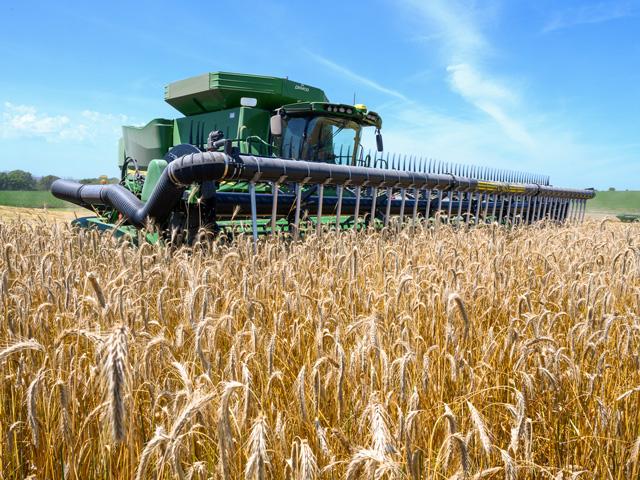Whiskey and Rye: Making Cover Crops Pay
Iowa Farmers Sell Cereal Rye for Seed and Spirits
ANKENY, Iowa (DTN) -- Gaesser Farms harvests and sells a small portion of its cereal rye cover crops to help make the conservation practice pay.
For years, Ray and Chris Gaesser have sold cereal rye to other farmers for seed. This year, for the first time, the father and son sold 1,000 bushels of cereal rye to Revelton Distilling Co. in Osceola, Iowa, shortly after harvest in mid-July. The transaction, Chris said, will ensure cover crops remain a profitable practice for the southwest Iowa row-crop operation near Corning.
Chris Gaesser visited Revelton in early September to make sure the farm's cereal rye quality was sufficient to make high-quality bourbon and whiskey. A taste test provided that answer, along with an agreement to sell the distillery 9,000 bushels next year, which will meet all its rye needs.
"I got to taste a little bit of Shine (a white whiskey) straight out of the still and it was good," Chris Gaesser said.
Revelton President and Primary Distiller Rob Taylor said buying cereal rye from a local farm is a win for everyone. Due to Taylor's personal relationship with the Gaessers, he's confident the grain will make tasty spirits because he knows it's properly grown, cleaned and stored. Plus, paying a farmer for a cover crop encourages more to be planted, which helps the environment.
"The Gaessers are incredible conservationists," Taylor said. "Iowa farmers get paid a premium price (for cereal rye), but we still have to be concerned about our price structure. We have a great symbiotic relationship."
P[L1] D[0x0] M[300x250] OOP[F] ADUNIT[] T[]
Revelton paid the Gaessers $12.50 per bushel for rye this year. Next year's price is expected to increase to $14 to $15 per bushel, pending market value.
The Gaessers have planted cover crops since 2010 -- about 3,500 acres of cereal rye last year or 65% of the farm's total acreage -- to improve soil health and resiliency and prevent erosion. As a result, Chris said fieldwork can resume at least a day faster after a big rain in cover crop fields than non-cover crop acres. The practice protects valuable topsoil and soil tests show organic matter has increased 0.5% in the last seven years. Cover crops have contributed to corn and soybean yield increases of 5 to 10 bushels per acre (bpa), he asserted.
Making cover crops profitable was also a goal. The family did so through increased crop yields, lowering herbicide expenditures due to weed suppression benefits, growing and cleaning their own seed to lower costs and selling cereal rye for seed (a minimum of 1,000 bushels per year) and now to Revelton.
Chris Gaesser estimates it costs $15 to $17 per acre to broadcast seed cereal rye cover crops after corn and soybean are harvested. Broadcast-seeded cover crops won't be harvested for seed and terminated in the spring.
It costs about $30 per acre to plant cereal rye that will be harvested for seed, Chris estimates. The higher production cost is due to cereal rye being drilled, not broadcast seeded, and 100 pounds of nitrogen per acre is applied to boost yields.
This year, the Gaessers harvested 100 acres of cereal rye, averaging 63 bpa; 45 to 60 bpa is common, Chris said. Next year, with the Revelton contract, they plan to harvest 400 acres. The family keeps between 3,000 to 3,500 bushels for their own use and they sell the rest.
The Gaessers sold cereal rye seed this year for $12 per bushel, though in the past prices ranged from $9 to $16 per bushel.
Profits for harvested cereal rye average $200 per acre, Chris Gaesser estimates. For non-harvested cover crop acres, he said soil health and agronomic benefits usually more than pays for the practice.
"There's a lot of tertiary benefits to cover crops, but early on we knew we needed to find a way to make them work (financially)," Chris said. "If you want to make something work, and you're creative enough, you'll find ways to do it."
To learn more about Revelton Distillery, go to www.reveltondistillery.com.
Farmers considering planting cover crops before or after harvest can find out if the conservation practice pays by utilizing the Cover Crop Net Return Economic Simulator developed by the Iowa Soybean Association. To learn more about the simulator, read this DTN article: https://www.dtnpf.com/…
Matthew Wilde can be reached at matt.wilde@dtn.com
Follow him on Twitter @progressivwilde
(c) Copyright 2022 DTN, LLC. All rights reserved.






